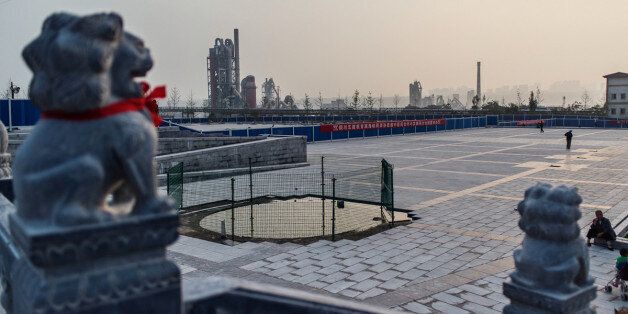
TONGCHUAN, China -- World leaders are gathering Tuesday at the United Nations in New York City, hoping to talk their way out of decades of gridlock on climate change. The high-minded proclamations will make international headlines, but the reality is they matter little compared with what's happening in places like Tongchuan, a dusty, smog-shrouded city in the beating black heart of Chinese coal country. This is a region where a large chunk of the world's carbon emissions originate, and this is where government pollution controls and anemic markets for coal may provide the best hope of averting a climate disaster.
Tongchuan has long been emblematic of China’s take-no-prisoners approach to environmental resources, scraping as much coal as possible from the earth and feeding it into local cement factories. But collapsing coal prices, depleted natural resources and government pollution controls are forcing the city to reinvent itself.
After riding a 10-year export and infrastructure binge, China’s coal markets have slumped as the economy attempts to move toward services and domestic consumption. The China National Coal Association estimates that 70 percent of coal producers are losing money, and early 2014 saw China’s first sustained drop in coal consumption in decades.
Those market forces have been complemented by aggressive anti-pollution measures that followed a series of air quality disasters in recent years. Tongchuan’s home province of Shaanxi has pledged a 13 percent reduction in coal consumption by 2017, and Greenpeace estimates that if China meets all of its coal targets, the country's 2020 emissions would drop by an amount equal to the combined 2013 emissions of Australia and Canada.
With over half of the world's emissions growth in the last decade coming from Chinese coal, making a dent in the country's use of the fossil fuel would be momentous for the climate. But political will to meet those targets could easily evaporate if the wrenching changes cause economic or political turmoil.
“The targets are very, very ambitious,” said Ailun Yang, a senior associate with the World Resources Institute, a global research organization focused on preserving natural resources. “I don’t think people have figured out how you can achieve the target without having major impacts on the economy and unemployment.”
Tongchuan is in the midst of working that puzzle out for itself. The city is already running short on its finite coal reserves, and as it makes the delicate transition away from coal and concrete, it’s banking on major growth in an unlikely sector: “Red tourism.” Tongchuan is playing up its role as a cradle of the communists’ Red Army, hoping to lure China’s urbanites out to a small ex-mining village that once served as the base for legendary bands of peasant guerillas.
Here in Zhaojin Village, former coal miners and corn farmers have had their jobs erased and their land purchased by the government to make way for a monument to China's Communist Revolution, accompanied by a new driving range and artificial ski slope. The provincial government has invested hundreds of millions of dollars over the past two years to construct these facilities, hoping that tourist dollars can fill the gaping hole left by abandoned mines.
See more photos of the changes in Zhaojin here.
But for locals lacking the tools to take advantage of it, an influx of tourism investment hasn’t brought relief from the collapse of a bedrock industry. Just past the planned driving range and ski slope is Blackfield Corn Village, where a winding one-lane road dead ends at two locked gates. Behind the gates are coal mines that were ordered closed after a gas explosion at a neighboring mine killed 11 miners in 2011.
Just 30 yards from the locked gates, Rao, who would only give her last name, said her husband worked detonation in the mine and missed the disaster by a matter of minutes. Despite this good fortune, the impact of the explosion still hit the couple and their young daughter hard. The family's entire livelihood was connected to those coal pits, Rao said. She used to run a small store for the miners out of the one-room house, and her husband worked underground for over a decade.
“We moved here because of the mines, but now we’ve got nothing to do,” she said. “Maybe when our daughter gets a little older we’ll move away, but for now we’re just getting by on odd jobs.”
The family doesn’t own any land in the village, so they're supplementing their meager income by picking walnuts off other villagers’ property and then selling them. Plans to open the driving range and ski slope offer the potential for work down the road, but Rao said she thinks the good jobs will go to those with the education that she and her husband lack.
If the tourists do make their way out to Zhaojin, 24-year-old An Rongbo will be there to greet them. Growing up in a neighboring village, An came of age in the Zhaojin of old.

“Back then people were only doing two things: mining and farming,” An recalls. “My dad worked in coal mines, and he’d plant some stuff on our land, too. But with that kind of income, it was hard enough just to pay for my high school tuition.”
An said he was one of the very few village kids to go to college, and he leveraged a bachelor's degree in tourism management into a job curating an exhibit on Zhaojin’s development. A job like this is the only thing that could’ve drawn him back to his hometown, where he can live with his family, he said.
Tourism has provided a crutch for places like Tongchuan as they try to lessen their dependence on coal. But for other Shaanxi towns like Longmen, collapsing coal markets are tightening the screws on already poor communities. Longmen’s name translates to “Dragon’s Gate,” and the city’s skyline lives up to the moniker: Smokestacks rim the horizon like jagged teeth, each spewing its own flavor of pollutants into the muddy sky.
Up in the smog-blanketed hills north of Dragon’s Gate, residents describe illegal coal mines as the area’s “local specialty.” But even those mines, which operate outside the reach of regulators and without documents or permission, can’t circumvent straightforward economics: Coal prices have dropped so low that digging it up is a losing proposition.
One local resident who helps illegal mines recruit out-of-town miners said that the high times are long gone for people in his line of work.
“It used to be that every single night we’d be throwing money at anything and everything: drinking, karaoke, going to ‘massage parlors,’” the 25-year-old, who requested anonymity because of his line of work, recalled wistfully. “It’s not like that anymore. Now we can only do that a couple times a month.”
Back in Zhaojin, locals are still grappling with the transition and looking for ways to gain a foothold in the new economy. Dong Yanli worked in the mines for six years but left when the hard times started cutting into his salary. Now he runs a fruit and meat shop on the edge of Zhaojin’s new tourist district.
“Sometimes the mines won’t pay you anything for two or three months. What’s our kid going to eat then?” Dong said. “The fruit stand doesn’t make us much, but it’s just enough to support the family. That’s about all you can say.”
Tina Tian contributed reporting from Tongchuan and Longmen.
